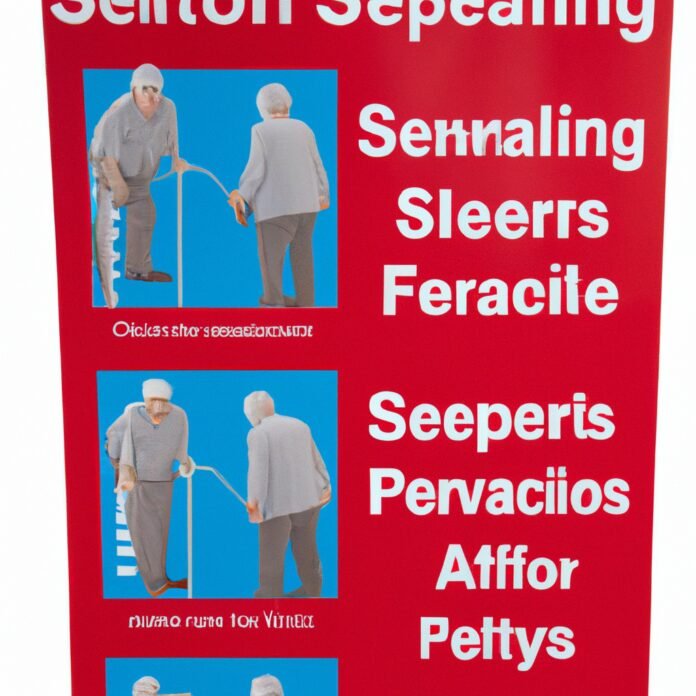As we age, our bodies may not be as agile as they once were, making us more susceptible to falls. For seniors, a fall can have serious consequences, such as broken bones and head injuries, leading to a loss of independence and a decline in overall health. Fortunately, there are steps individuals can take to prevent falls and reduce their risks. In this article, we’ll explore ways seniors can enhance their safety and prevent fall-related injuries, from simple modifications to their homes to exercises that improve balance and coordination.
1. Stepping Forward: Understanding the Importance of Falls Prevention for Seniors
Falls prevention is crucial for seniors as they age, and understanding the importance of it can help make a significant impact on their lives. According to statistics, falls are the leading cause of injury and hospitalization for seniors, and unfortunately, the number of falls has been increasing over time. It is essential to step forward and take action to prevent falls so that seniors can remain healthy and independent.
One way to prevent falls is to promote an active lifestyle that includes regular exercise and physical activity. Exercise helps improve balance, strength, and flexibility, all of which are essential for preventing falls. Seniors can participate in various activities like walking, dancing, or yoga to improve their balance and muscle strength.
Another critical factor in falls prevention is to assess and reduce the risk of falls within the home environment. Simple modifications like removing clutter, securing loose rugs, installing grab bars in the bathroom, or improving lighting can all help reduce the risk of falls. Seniors should also consider wearing appropriate footwear with good support and fitting soles to help prevent slips, trips, and falls.
By promoting an active lifestyle, assessing and reducing the risk of falls within the home environment, and wearing appropriate footwear, seniors can significantly reduce the risk of falls. Taking action to prevent falls is essential for maintaining a healthy, independent lifestyle for seniors.
2. Contemplating the Consequences: The Risks and Implications of Falls for Older Adults
As individuals age, they are more susceptible to falls. A fall can lead to a series of health issues that can become debilitating and even result in death. It is, therefore, important to consider the possible risks and implications of falls on older adults.
One of the primary issues that accompany falls in older adults is fractures. The frail bones in a senior’s body are more susceptible to fracture, and this can lead to hospitalization and prolonged recovery periods. Additionally, the psychological impact of falls can result in fear and anxiety, causing restrictions in daily activities.
Another consequence of fall for older adults is head trauma. This can lead to brain injuries that may cause memory issues, confusion, and dementia. Furthermore, falls can result in muscular damage, particularly in the upper and lower limbs, which can lead to impaired mobility.
It is essential for older adults to take precautionary measures to prevent falls, such as maintaining a healthy lifestyle, regular medical checkups, and ensuring their home environment is secure. Any signs of unsteadiness, dizziness, or vertigo should be brought to the attention of a medical professional immediately.
In conclusion, falls in older adults can have significant ramifications, including fractures, head trauma, and muscular damage. It is imperative to take steps to prevent falls and prioritize maintaining physical and mental well-being.
3. Building Strong Foundations: Proactive Measures to Mitigate Fall Risk in Seniors
Fall risk is a significant concern for seniors, and it is essential to implement proactive measures to prevent falls. Here are some tips to help reduce the risk of falls in older adults:
• Conduct a home safety assessment. Identify potential hazards, like loose rugs, poor lighting, and cluttered walkways that may cause falls. Repair or remove these hazards as soon as possible.
• Encourage physical activity. Regular exercise can improve balance, flexibility, and strength, ultimately reducing fall risk. Encourage seniors to engage in activities that they enjoy, like walking, dancing, or yoga.
• Review medications. Some medications can cause dizziness or loss of balance. Review all medications with a doctor or pharmacist, and consider reducing or changing any that cause adverse side effects.
• Wear appropriate footwear. Ensure that seniors wear properly fitting shoes with low heels, good support, and non-slip soles. Avoid shoes that have laces that can become untied and cause tripping.
Taking proactive measures to reduce fall risk in seniors is crucial for building a strong foundation for their overall health and well-being. A combination of home modifications, regular exercise, medication review, and appropriate footwear can significantly reduce the risk of falls, promoting longevity and a higher quality of life.
4. Moving with Confidence: Exercise and Mobility Strategies to Enhance Safety and Reduce Falls
It’s important for seniors to maintain good physical health in order to reduce the likelihood of falls and maintain independence. Exercise and mobility strategies can provide many benefits, including increased balance, improved mobility, and better flexibility.
One effective exercise strategy for seniors is resistance training. This involves using weights, resistance bands, or bodyweight exercises to strengthen muscles and improve balance. Tai chi and yoga are also great options for improving balance, flexibility, and strength.
Another important aspect of mobility is maintaining good posture. This can be achieved by doing exercises that target the core muscles and practicing good posture throughout the day. Seniors can also use assistive devices like canes or walkers to help maintain stability while walking.
In addition to exercise and posture, seniors can take other safety precautions to reduce their risk of falling. Lighting should be improved throughout the home, particularly in areas where falls are more likely. Slip-resistant flooring and grab bars in the bathroom can also enhance safety. With these strategies and a commitment to staying active, seniors can move with confidence and reduce their risk of falls.
5. Steadying the Path: Assistive Technologies for Fall Prevention and Improved Senior Life Quality
Assistive technologies can come in handy for ensuring the safety of seniors at home. According to the World Health Organization (WHO), falls are one of the leading causes of injury and death among older adults. With technology-equipped homes and safer living environments, these incidents can be significantly reduced.
There is a wide range of assistive technologies available in the market today aimed at seniors. Some of these are designed to track physical activity, monitor vital signs, and remotely connect seniors with healthcare providers. Others are geared towards fall prevention. For example, bed rails can provide a more secure environment and lessen the likelihood of nighttime falls. Rubber mats, grab bars, and non-slip surfaces can also help prevent falls in the bathroom.
Another category of assistive technologies includes mobility aids such as power scooters, wheelchairs, and walkers. These devices can help reduce the risk of falling and improve mobility and independent living for seniors. They can also help them feel more comfortable and confident moving around their homes and in other environments.
In conclusion, assistive technologies play a key role in fall prevention and improving the quality of life for older adults. There is a broad range of devices and equipment available, and it is essential to choose the right ones suitable for a particular individual’s needs. As more technologies are being developed, caregiving for seniors is becoming more accessible and more effective.
6. Clearing the Clutter: Home Safety and Environmental Modifications to Minimize Falls
Creating a safe and clutter-free home environment is essential to prevent falls. Injuries due to falls can cause significant harm, especially among older adults and young children. Some environmental modifications can be made to minimize the risk of falls and injuries in the home.
Firstly, removing clutter and keeping the floors clear is essential. Removing throw rugs and securing carpets with slip-resistant backing is vital to prevent falls. Additionally, furniture should be arranged in a way that provides ample space for easy movement around the room, especially in high-traffic areas.
Installing handrails and grab bars in bathrooms, staircases, and hallways can offer stability and support. A well-lit home environment and replacing burnt-out light bulbs are also essential for fall prevention. Making sure that extension cords and other wires are neatly stored away from walkways will prevent tripping hazards.
Furthermore, installing child safety gates to prevent access to stairs and other areas can reduce the risk of falls. Childproofing cabinets and storing harmful products out of reach can also be helpful in preventing injuries.
In summary, keeping the home environment free of clutter and implementing essential safety precautions can significantly reduce the risk of falls, especially among children and older adults. By implementing these measures, we can create a safe and comfortable home environment while minimizing the risk of falls and injuries.
7. Community Support: The Role of Health Professionals and Caregivers in Promoting Senior Falls Prevention
Senior falls prevention is a crucial aspect of aging well, and it requires community-wide efforts to ensure that seniors remain safe and secure in their homes. Health professionals and caregivers play a critical role in promoting senior falls prevention by creating awareness, providing education, and sharing resources and tips with seniors and their families.
Health professionals, such as physicians, nurses, and physical therapists, can lead the charge by integrating falls prevention into routine medical care. This can include conducting fall risk assessments, screening for medical conditions that may contribute to falls, and providing evidence-based interventions to mitigate risks. By emphasizing the importance of falls prevention, health professionals can help seniors understand the need to take preventative measures to avoid falling.
Caregivers, meanwhile, can be an invaluable resource in implementing falls prevention strategies and promoting safety in the home environment. This can involve ensuring that the home is well-lit and free of hazards, assisting with medication management to avoid side effects that may increase the risk of falls, and encouraging seniors to stay active and engaged in safe physical activity. Additionally, caregivers can provide emotional support to seniors by listening to their concerns and facilitating social connections that can reduce isolation and loneliness.
The roles of health professionals and caregivers in promoting senior falls prevention are varied, but they share a common goal of ensuring that seniors can maintain their independence and stay safe in their own homes. By working together and advocating for falls prevention strategies, health professionals and caregivers can make a significant impact in reducing the incidence of falls among seniors.
In conclusion, falls prevention is a crucial aspect of senior care, and measures should be taken to enhance safety and reduce risks. With the right knowledge, tools, and support, seniors can successfully navigate their daily lives without the fear of falls. By making small changes and staying proactive, seniors can maintain their independence and improve their quality of life by ensuring their safety. If you know a senior who could benefit from falls prevention strategies, don’t hesitate to lend a helping hand. Together, we can create a safer and more supportive environment for our aging loved ones.


